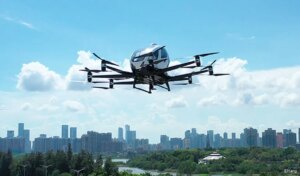The Dawn of Pilotless Air Taxis: China Leads the Way

Image Credit: Armstrong Economics
Imagine a future where flying cars are not just a figment of science fiction but a part of our daily commute. Well, that future seems to be closer than ever, thanks to groundbreaking innovations emerging from China. The nation has recently made headlines by launching the world’s first pilotless air taxi service. This remarkable achievement, certified by the Civil Aviation Administration of China (CAAC), marks a pivotal moment in the realm of transportation.
EHang’s Groundbreaking EH216-S
At the forefront of this revolution is the EHang EH216-S, an electric drone designed to carry two passengers. With a top speed of 80 mph (130 km/h) and a range of 18.6 miles (30 km), this flying vehicle is poised to redefine urban air travel. Heyi Aviation, another player in this burgeoning industry, has also rolled out a similar model specifically for low-altitude flights.
According to EHang’s Vice President, He Tianxing, the first phase of this pilotless taxi initiative will launch this year and extend into 2026, exclusively targeting tourism in cities like Zhuhai, Shenzhen, and Wuhan. The initial flights will focus on quick, exhilarating jaunts lasting between three to ten minutes, aimed at providing an experience akin to riding in a car.
The Low-Altitude Economy: A New Frontier
EHang’s vision aligns with a growing trend they term the “low-altitude economy.” This concept is a strategic focus for China’s aviation sector, aiming to cultivate an industry that encompasses human-carrying vehicles, drones, and even air sports. However, industry experts caution that before this vision can fully materialize, numerous challenges must be addressed and collaborative efforts across sectors will be crucial.
After the initial phase, from 2026 to 2030, the air taxi services will expand to include urban commutes. Imagine zipping across cities without the hassle of traffic, a concept that could bring about a major shift in how we think about urban mobility.
Competing with the U.S.: A Global Race for Air Mobility
Across the globe, the United States is not sitting idle. Efforts are underway to introduce electric Vertical Takeoff and Landing (eVTOL) vehicles designed to operate without needing traditional runways. However, unlike China’s advancements, the Federal Aviation Administration (FAA) has yet to approve any pilotless aircraft. Experts estimate that the eVTOL market in the U.S. could burgeon into a $30 billion industry by 2035 — a hint at the fierce competition brewing in the skies.
The Future is Bright (and Lucrative)
China expects its low-altitude economy, inclusive of various aerial innovations, to be valued at a staggering $205 billion (1.5 trillion yuan) by the end of 2025, with aspirations to double by 2035. What was once relegated to the realms of science fiction is rapidly transforming into a tangible reality.
At Extreme Investor Network, we believe this shift in transportation paradigms presents unique investment opportunities and insights that cannot be overlooked. The future of travel lies in the skies, and those who recognize the potential early on will be in prime positions to reap the benefits.
Stay tuned to our blog for more insights into how these technological advancements could reshape not just travel, but also the very fabric of urban living and economic dynamics in the years to come.
This fresh perspective on the pilotless air taxi craze not only informs readers about the latest developments but also highlights investment opportunities and the potential economic impact of this new frontier. By offering unique angles and insights, we aim to make Extreme Investor Network your go-to source for high-quality economic content.

